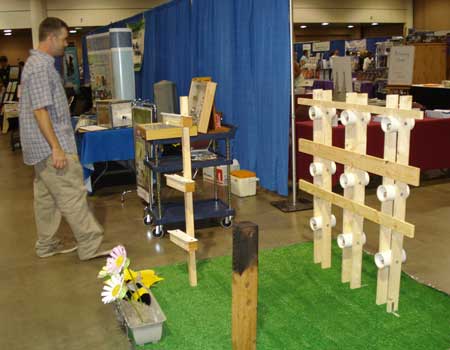
Environmental initiatives sweep Future of the Region awards program
A series of environmentally oriented projects took top honors at the 23rd annual Future of the Region awards program coordinated by the Tampa Bay Regional Planning Council.
The most prestigious honor, the Charles A. McIntosh Jr. award, went to Water Works Park developed by the city of Tampa. The new park on the Hillsborough River is highlighted by a natural spring that attracts both manatees and people (see Bay Soundings, Winter 2011 http://baysoundings.com/urban-oasis-for-manatees-under-construction/) as well as areas for special events, play areas and a dog park.
In the natural resources and environment category, first place was awarded to the Tampa Bay Estuary Program’s master plan for the protection & restoration of freshwater wetlands in the Tampa Bay watershed, the first plan to develop protection and restoration targets for freshwater wetlands in the region.
Second place went to the city of Palmetto Community Redevelopment Agency for Dr. Martin Luther King, Jr. Park, a 5-acre low-impact multimodal park that provides recreation for urban residents while removing harmful pollutants from the Manatee River by pre-treating stormwater. Palmetto’s CRA also earned third place for its “Fourth Festival” in the nearby low-impact Sutton Park.
The top Going Green! spot was earned by Pasco County for an innovative study with the University of Florida that now allows ash left over from its waste-to-energy plant to be used in road construction.
On a smaller scale, the seed library at the City of Dunedin Public Library was awarded second place in the Going Green! Category for “changing the world, one seed at a time.” Dunedin also took the third place award for its new fire station built with sustainability, durability and energy conservation in mind.
[su_divider]“BYOB” project set for Temple Terrace
A month-long “Bring Your Own Bag” project is planned for Temple Terrace in July to highlight the problems caused by single-use plastic bags. “It’s not a political event,” said Friedemann Buschbeck, a Temple Terrace resident. “It’s just a way for us to show people how easy it is to bring their own bags – and how much difference it can make it our community.”
The average American uses about 700 bags per year but less than three percent are recycled. They’ve become a major source of human-related debris on the seabed, particularly in coastal areas, according to a 2007 Worldwatch report. “They cost about two cents to make but it costs taxpayers 17 cents to clean up the litter they create,” Buschbeck said.
Although Florida retailers have successfully fought an outright ban on free plastic bags, more than 130 cities have regulated their use. International retailers like Ikea and Aldi, as well as US-based Whole Foods, also do not give out free bags but it doesn’t seem to hurt their business, he adds.
Learn more at facebook.com/PlasticFreeJuly?fref=photo
[su_divider]Water-Wise award deadline is June 30
Deadline for the 2015 Community Water-Wise awards is June 30. Designed to recognize attractive, water-conserving landscapes in homes and businesses, the program highlights actual examples of Florida-friendly, water-wise landscaping to promote those principles within the community.
Landscapes must be located in unincorporated areas of Pasco, Pinellas or Hillsborough counties or the cities of New Port Richey, St. Petersburg or Tampa. Judges will review an online application for the award and then schedule site visits with the entrants whose landscapes meet minimum qualifications.
An entry form and further information are available at tampabaywaterwise.org/
[su_divider]
Citizen scientists busy as bees
Volunteers from around the world have built more than 10,000 potential nests to help researchers at the University of Florida determine which artificial habitats native bees prefer.
The well-known honey bees are not native to the Americas, although they arrived here with the earliest pilgrims. More than 4,000 species of bees are native to the US, and may play an ever-more important role in pollinating food because they appear to be immune to colony collapse disorder than has decimated honey bee populations.
Much less is known about native bees than the commercially important honey bee, so researchers reached out to citizen scientists to identify which bees are present in which areas and what type of habitat they prefer.
Between April 2012 and July 2014, 655 people from 30 Florida counties, 39 states and 11 countries registered for the Native Buzz project. They built 10,657 potential nests from various materials, then monitored nest sites weekly to see if bees and wasps actually established nests.
Until 2014, entomologists had published surveys of only four of Florida’s 67 counties – Alachua, Miami-Dade, Highlands and Monroe — to document bee and wasp diversity, said UF doctoral student Jason Graham, who is now a post-doctoral researcher at the University of Hawaii. Results of the latest two years of the study are published in the recent issue of Florida Scientist.
“Many of the problems facing honey bees were first detected by beekeepers who monitor, care for and maintain their own hives,” Graham said. “However, we know very little about the pests, diseases and other problems facing solitary bees and wasps, and most of what we do know comes from scientists. This project creates the opportunity for many people to learn about these beneficial insects and to participate in solitary bee and wasp research and conservation.”
Learn more – including how to build your own bee nests at ufnativebuzz.com/
[su_divider]